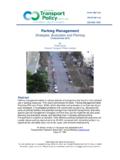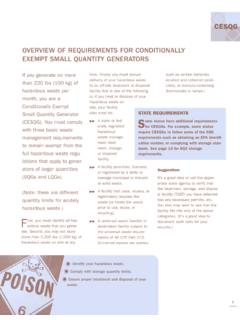Transcription of Oxygen: Health Effects and Regulatory Limits Part I ...
1 oxygen : Health Effects and Regulatory Limits Part I: Physiological and Toxicological Effects of oxygen Deficiency and EnrichmentNeil McManus, CIH, ROH, CSPN orthWest Occupational Health & SafetyNorth Vancouver, British Columbia, 2009 NorthWest Occupational Health & SafetyParts of this document were excerpted from Safety and Health in Confined Spaces. The ideas presentedhere represent opinions of the author and are intended solely to promote the biggest source of confusion and controversy involving confined spaces is the acceptable limitfor atmospheres deficient or enriched in oxygen . This confusion and controversy has arisen, in part,because oxygen is essential for life, and because people can adapt in both the short-term and the long-term to oxygen levels both greater than and less than they are at sea level. Sea level, of course, is merelya convenient altitude of reference.
2 There is no particular significance to this altitude, as people live andwork quite comfortably at attitudes far below and far above this height. oxygen DeficiencyComplicating things further is the fact that the condition present at the legal limit for workplace exposure( ) can be encountered at an altitude of 610 m (2000 feet). This altitude is readily accessible by carfrom sea level in many areas. One, in fact, can drive to this altitude and go considerably higher andexperience no noticeable symptoms, and then be left to wonder what is the purpose for this choice andwhat is the concern that it levels are measurable in units of concentration and partial pressure. oxygen concentrationremains constant within normal habitable altitudes. This results from the relative constancy of compositionof the atmosphere (Moran and Morgan 1989). Total atmospheric pressure, and by implication, thepressure of oxygen , vary according to altitude and barometric pressure.
3 The pressure of the normalatmosphere at sea level is 760 mm Hg (millimetres of mercury). The concentration of oxygen in thenormal atmosphere is of the total of the gases (mainly nitrogen and oxygen ). The pressure, but notthe concentration of oxygen , decreases with deficiency is a major concern in the occupational setting and the subject of several standards andmany regulations. Typically, the following Table 1 or a similar version which, appears in publications,summarizes the Effects of acute exposure to oxygen -deficient atmospheres as commonly reported basedon concentration and partial pressure (after NIOSH 1976a, Miller and Mazur 1984, after ANSI 1992, afterCSA 1993). (For explanation of the acronyms, please refer to the glossary at the end of the document.)The origins and wording of this table are not readily apparent. The table does not appear historically in theANSI standards on confined spaces (ANSI 1977, ANSI 1989, ANSI 1995, ANSI/ASSE 2003), nor NFPA Table 1 Effects of Acute Exposure to oxygen Deficient Atmospheres Atmospheric oxygen (dry air, sea level)
4 EffectConcentration%Pressure mm Hgno symptoms16 to to 159increased heart and breathing rate, some loss of coordination,increased breathing volume, impaired attention and thinking16122abnormal fatigue upon exertion, emotional upset, faulty coordination,impaired judgment14106very poor judgment and coordination, impaired respiration that maycause permanent heart damage, nausea and vomiting1291nausea, vomiting, lethargic movements,perhaps unconsciousness,inability to perform vigorous movement or lossof all movement, unconsciousness followed by death< 10< 76convulsions, shortness of breath, cardiac standstill, spasmatic breathing, death in minutes< 6< 46unconsciousness after one or two breaths< 4< 30306 which is concerned with gas hazards on ships (NFPA 1988, NFPA 1993). NFPA 306 dates back information is also absent from historical publications by NIOSH on confined spaces (NIOSH 1979).
5 Articles on confined spaces, such as, Anonymous, 1967, and Allison 1976a and Allison 1976b, do providesome discussion about oxygen deficiency. The latter article by Allison (1976b) indicated that foroxygen was the accepted percentage to support life . Miller and Mazur (1984) reference Beard (1982) andCooper (1981) as sources of their information. The information contained in Table 1 does appear in historic standards on respiratory protection (ANSI1980) and guides (NIOSH 1976a). (Note,.that ANSI standards on respiratory protection preceded theexistence of NIOSH.)The ultimate origins of the information appear to reflect experiments performed in aerospace medicineand later adopted as the basis for discussion by the ANSI committee on respiratory , such as NASA (1964) and NASA (1973), contain information possibly used in laterreferences, such as Davis (1979), and also provide historical situation highlighted in Table 1, along with comments reflected in the articles by Allison (1976a and1976b), hint at the complexity of the questions raised.
6 The outcome of situation apparently reflects thedivergence of vision of two groups on how to manage the reality within which people work within theenvironmental reality in which people live. These environments present contradictions and complexitiesthat deserve acknowledgement and recognition in order to manage the combined reality in a beneficialand unambiguous manner. In order to do this, the following background information is Confined Space Accidents and Atmospheric HazardsOf considerable interest to the industrial hygienist is the composition of contaminated atmospheresassociated with accidents that occur in confined spaces (McManus 1999). This information provides thekey to better understanding about the hazardous nature of these workplace environments. Ultimately, thisinformation would determine the nature and scope of the response needed to address and manage theseconditions.
7 OSHA and NIOSH reports on fatal accidents occurring in confined spaces provided the mainsource of information about this subject in recent times (OSHA 1985, NIOSH 1994). Both reports provideddescriptive summaries of individual accidents. These made possible further speculation about thecomposition of the atmosphere present at the time of the accident. Sometimes the summary alluded to thepresence of more than one hazardous substance. Unfortunately, these summaries provided little or nomeasurement data about the composition of the hazardous atmosphere involved in the accidents. Anecdotal information in the accident summaries provided some indication that these atmospheres aremore complex than originally described. As well, there are discrepancies between the progression ofevents that actually occurred versus what could be expected based on controlled studies of the toxicagents implicated in the accidents.
8 That is, the outcomes produced by some of these substances undercontrolled conditions differed from what was observed during accidents attributed to them. Considerable similarity exists in the progression of events in individual accidents involving hazardousatmospheric conditions. During a typical accident, the victim usually is affected by the atmosphericcondition either at the time of entry or soon afterward. This individual collapses and may yell for help, or isdiscovered soon afterward by someone outside the space. The discoverer or some other individual nearbyundertakes the role of would-be rescuer and enters the space without ventilation or respiratory would-be rescuer possibly succeeds in transferring the victim from the interior of the space to theaccess opening after expending considerable physical effort. The atmospheric condition in the spaceovercomes the would-be rescuer, who then collapses.
9 The would-be rescuer often collapses more rapidlythan the victim. Additional would-be rescuers may suffer the same fate as the first. These events all occurprior to response by individuals equipped appropriately for the rescue. Either the victim, a would-berescuer or both are fatally injured during this process. During a real-world accident, entrants often collapse either immediately or shortly after initial contact withthe hazardous atmosphere. This action suggests the presence of a rapidly acting, acutely hazardouscondition. The rapid onset of debilitation under real-world conditions contrasts with the slower action ofmany substances, including carbon monoxide and organic onset of unconsciousness following exposure to carbon monoxide occurs when carboxyhemoglobinsaturation exceeds 50% to 60% (NIOSH 1972). Saturation to the 50% level by an atmosphere containing1000 ppm requires approximately 180 minutes (Stewart & Peterson 1970).
10 This time sequence is muchtoo slow to account for the rapid onset of unconsciousness observed during actual accident discrepancy suggests that carbon monoxide alone was not the causative agent in these sulphide can cause rapid collapse when inspired in high concentration. Yet, in many accidentsin which hydrogen sulphide was implicated, and in which air sampling subsequently occurred, theconcentration typically was in the range of 50 ppm (OSHA 1985, NIOSH 1994). Concentrations in thisrange are sufficiently high to cause only eye irritation, not rapid collapse (NIOSH 1977). However, the testresults possibly were not reliable or loss of the source could have occurred following the high concentration, solvent vapours can cause rapid collapse. This response is consistent withsituations in which exposure to high concentrations of solvent vapours did occur.





